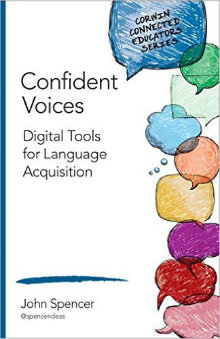Confident Voices: Using Digital Tools with ELLs
Confident Voices: Digital Tools for Language Acquisition
By John T. Spencer
(Corwin, 2016 – Learn more)

Depending on whether you are a glass-half-full or glass-half-empty kind of person, you will either find this book very helpful or rather frustrating.
Confident Voices is apparently aimed at ESL teachers who are new to using digital tools, but it seems as if it’s written for teachers who are new to working with ELLs but not new to using technology in their lessons. The author’s revelatory “a-ha” insights that he shares from his (non-tech) classroom instruction are standard practice for ESL teachers, yet when he discusses the various technology programs he uses, he writes as if readers already know what they are and how to use them.
An easy read with good ideas

The short introduction offers the rationale for using technology with ELLs – that “ELL students can thrive in project-based classrooms through the intentional, thoughtful integration of digital tools” (P. 3). Chapters on Grammar, Vocabulary, Oral Language, Writing, and Reading (Chapters 1 – 5) then proceed to describe various digital tools that help develop students’ academic language proficiency.
Each chapter begins with a vignette from the author’s ESL classroom; his biography says that he is an instructional technology professor who worked with ELLs for one year. I enjoyed these glimpses into his teaching in which he courageously writes about lessons that fell flat and how he changed his teaching as a result.
Chapter by chapter
In Chapter 1, “Grammar,” Spencer describes how blogging and podcasting can help students learn grammar structures. While the information is useful, when he writes on P. 11 that “Students who are still struggling with the verb tense get a chance to practice it with choice-based writing,” I would have liked to have seen some examples of that. However, there is a very helpful chart on page 13 that matches verb tenses with technology tasks and scaffolding ELLs might need to accomplish the task.
How to teach academic vocabulary to ELLs is a topic that gets a lot of attention nowadays, and the ideas in “Vocabulary” (Chapter 2) are very good. Although I had my ELLs create vocabulary logs on a wiki, and they could comment on each other’s entries, I think they would have gotten more out of the task if they had done some of the things mentioned in this chapter.
Spencer talks about using “the label function to find synonyms” (P. 17), “the tagging system” (P. 17), and the “‘reblog’ function” (P. 18) as ways to further the vocabulary development of ELLs, which all sound great, but I wish he had explained how to actually use those features.
Every chapter ends with two sections entitled “Next Steps” and “For Reflection.” Many of the steps are logical extensions of the information provided, but others are ambiguous. For example, how is “Keep in mind that many of these strategies take a lot of time at first but eventually they become efficient” (P. 21) a step that teachers can implement? Some of the reflection questions are good, and some I wish the author had addressed himself.
In “Oral Language” (Chapter 3), Spencer suggests using a voice commenting system such as VoiceThread. He then goes on to explains the benefits of using such a system. But nowhere does he actually explain what VoiceThread is or how to use it, nor does he mention any other voice commenting systems. For readers who are not familiar with them (I know what VoiceThread is only because I used it in my classes), it is frustrating to read this section – and many others in the book – because just enough information is given to pique your interest but not enough to enable you to determine whether you would like to try something in your own classes.
Many good ideas are offered but the detailed explanation that would make them classroom-ready for teachers just isn’t there. The author repeatedly recommends using sentence stems for various activities. Instead of telling teachers to create some, as he does on P. 28 in the “Next Steps” section of Chapter 3, “Oral Language,” it would have been far more helpful to include the list of sentence stems that he has used in his own classes. I would also have preferred to see a list of “digital recording tools that are quick and intuitive for students” (P. 28) included, rather than being told to make my own list.
I most enjoyed Chapter 4, “Writing,” which focuses on blogging and includes a very helpful list of ten things teachers should keep in mind when their students start to blog. It also offers many ideas for integrating digital tools in the writing process although, again, I wish more explanation about them had been provided.
Chapter 5, “Reading,” finally includes enough details about an activity for teachers to immediately implement it in their classrooms. After having students discuss what the phrase “information text” means to them, the author describes how students progress from asking “I wonder…” questions to researching answers to creating digital projects that answer those questions. If only the rest of Confident Voices were as thorough! Even the rest of this chapter, in which literature circles and reading fluency tasks are described, is not as detailed.
In his conclusion, Spencer describes five paradigm shifts that helped his ELLs develop their language skills. These will be obvious to ESL teachers. He then talks about the design process that he used with his students; this is useful and interesting, but I think it would have been more useful had it been included at the beginning of this book instead of the end.
Lots of ideas, not enough actions
ESL teachers who are looking for ideas on how to incorporate digital tools into their lessons will find good ideas here but not step-by-step instructions for implementing them. If its audience is intended to be ESL teachers, Confident Voices would have been much more helpful if it had delved more deeply into using the digital tools that are described.
This book will be most useful to mainstream teachers already familiar with the digital tools mentioned but who need suggestions for providing language support to their ELLs when doing technology-based projects.
Susan Schwartz taught EFL/ESL at universities in Asia and a public school in Massachusetts for 25 years and now creates digital education resources. She regularly used Web 2.0 and other technology tools when teaching her middle school ESL Social Studies classes and presented about her podcasting projects with ELLs at the TESOL Convention in 2010. Susan (@The_ESL_Nexus) co-hosts the monthly #ELLEdTech Twitter chat and blogs at The ESL Connection.


































